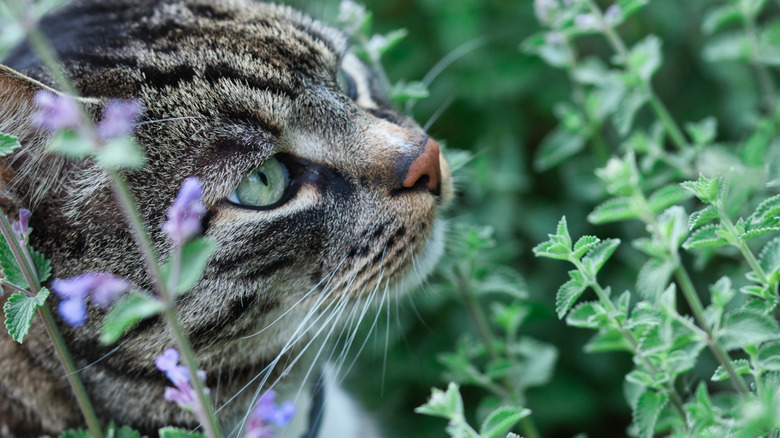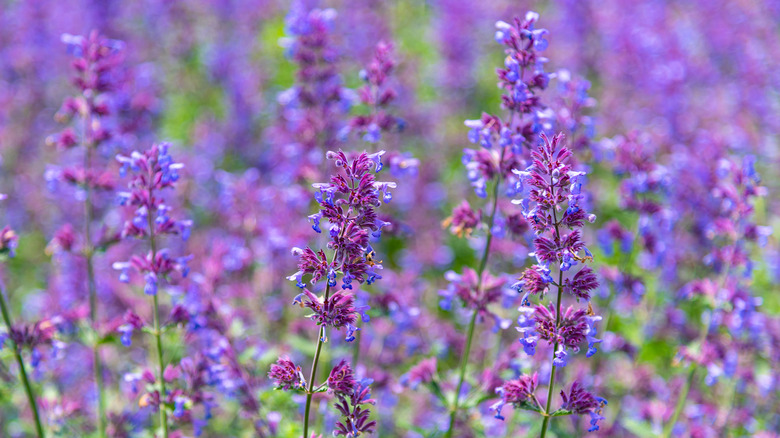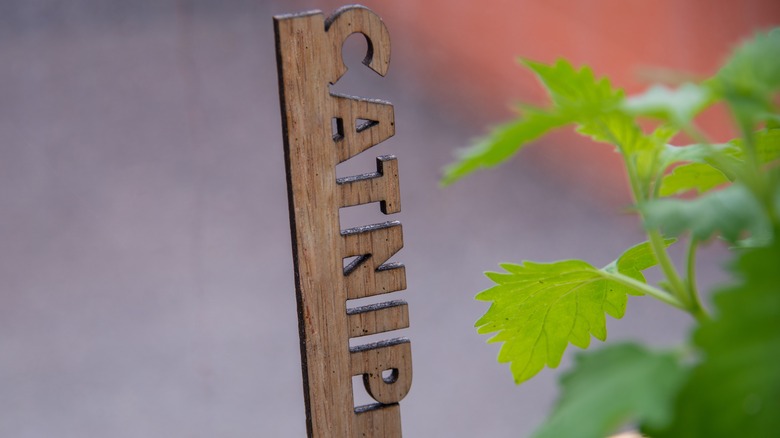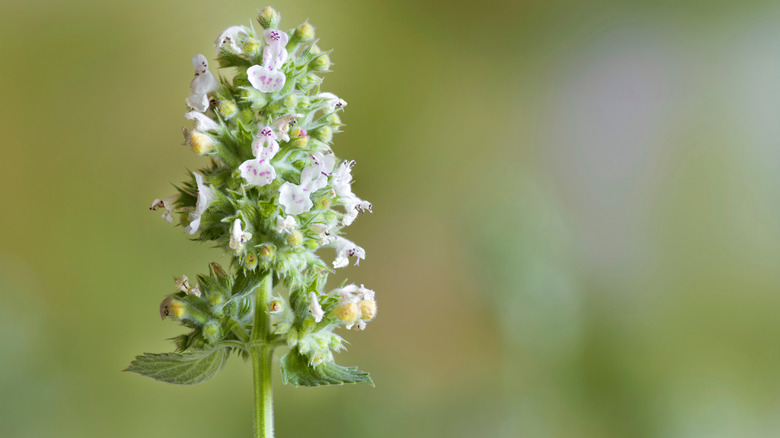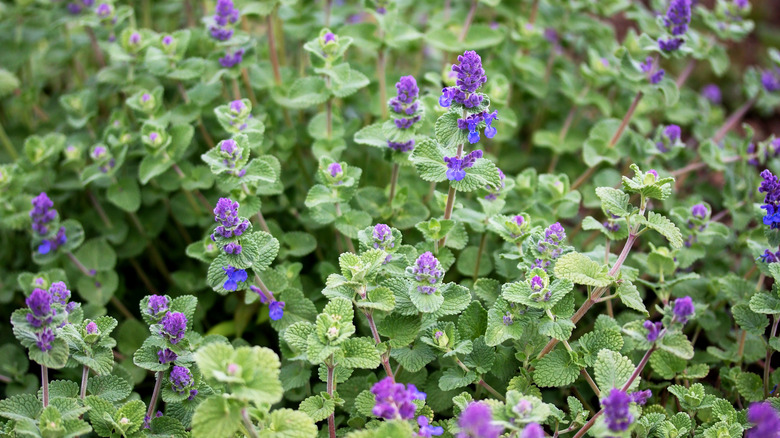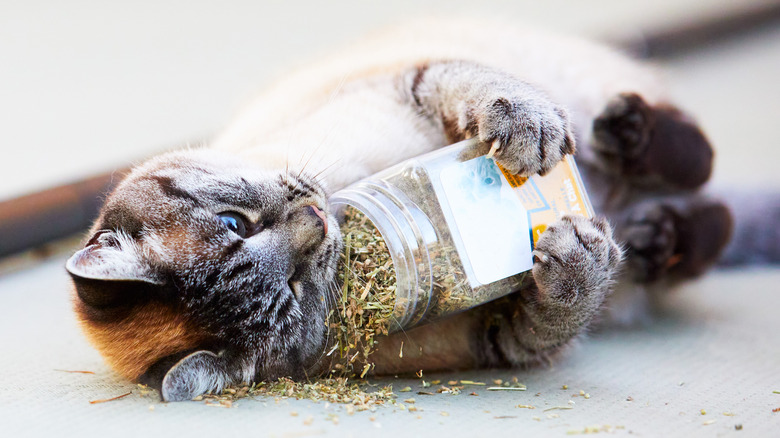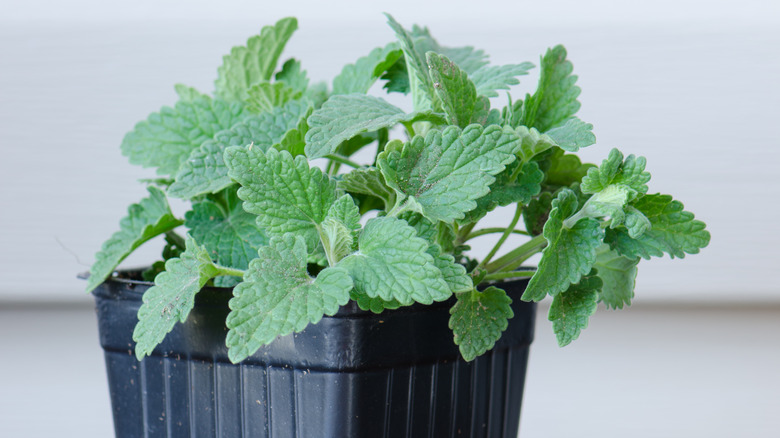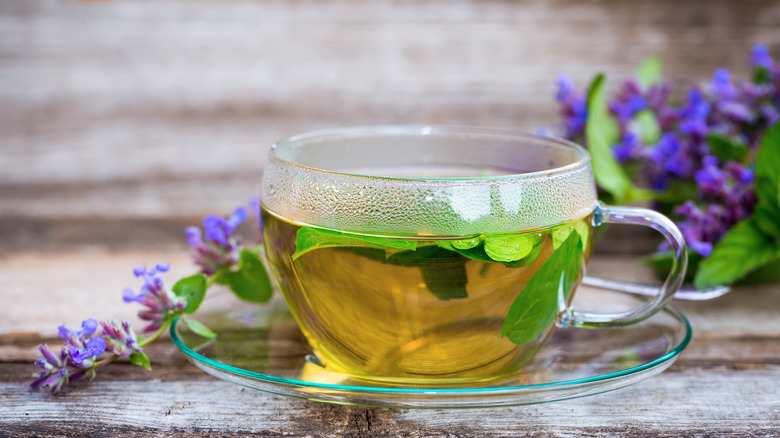How To Successfully Grow A Catnip Plant
Nepeta Cataria or catnip is an incredibly popular herb loved by cats, cat owners, and outdoor gardeners alike. Though you'll most often find it dried or fused into pet toys, you can also easily grow this flowering herbaceous perennial on your own. The plant is native to nearly all regions of the northern hemisphere, yet it originally grew in the drier areas of southern Europe, the Middle East, and Asia, noted Petal Republic.
The catnip plant is characterized by triangular, toothed leaves and bundles of small flowers ranging in color from white to light purple. It is simple to care for even if you are an inexperienced gardener. Catnip can be grown indoors or outdoors as it is suitable for many USDA hardiness zones. However, The Spruce reminded us that the plant could quickly grow out of control. Mature catnip plants can reach a height and width of up to 3 feet when left alone.
How to use catnip in the garden
Catnip can be a beautiful indoor potted plant, yet where it really thrives is out in the garden. This is because while the plant attracts cats, honey bees, and butterflies, it also repels harmful insects such as squash bugs, flea beetles, slugs, and aphids, as per Missouri Botanical Garden. Catnip happens to be an excellent companion plant to protect your favorite herbs, vegetables, and fruits. You can use the catnip plant as an alternative to the harsh chemicals found in insect repellants. In fact, the only plant that catnip does not make an excellent companion to is parsley, said Gardening Know How. Catnip, like mint, is a member of the Lamiaceae family. Their roots spread quickly and are known to damage the delicate root system of parsley plants.
Catnip is not exactly known as an ornamental garden plant, even though its blooms can be quite beautiful. Normally, experienced gardeners choose to position this plant on the outskirts of their plot, as borders or path edging, where excited felines won't accidentally harm nearby flowers. Growing catnip outdoors will encourage it to become more potent than indoor catnip. Yet, many cats enjoy both just the same.
How to grow catnip
Typically, catnip is grown from seeds, but you can find them already grown and ready to plant from your local nursery. While the latter is certainly easier, growing catnip from seeds might not be as difficult as you think. You can start by slightly damaging your seeds, said Gardening Know How. Catnip seeds are extremely tough and need to be put in the freezer or soaked in water for about a day to break down the seed coat before planting. After this, you can plant them into a pot with well-draining soil or directly into your garden in a sunny area. According to Bonnie Plants, you should only plant your catnip seeds in the spring once there is no more threat of frost. Be sure to space your seeds 1 to 2 feet apart and keep their soil moist. Once a little over a week has passed, you should begin to notice sprouts.
Your catnip plant will likely spread on its own, but you can propagate the plant with cuttings. The Spruce recommended starting by removing a substantial stem piece (4 to 6 inches) from your catnip plant. Then, cut or pick off the lower leaves of the stem. Next, place your cutting into water that you will replace daily. When left in a warm, bright spot, your cutting will grow a healthy root system in less than a week. At this point, you can transplant your plant into your garden or into a pot.
How to care for catnip
Catnip, like other herbs in the Lamiaceae family, is quite easy to take care of, particularly when it is kept outdoors. The plant needs a daily total of direct sunlight of at least six hours, explained The Spruce. Catnip that does not receive enough light will grow slowly and poorly. Yet, too much light can be problematic as well. If you live in a hot, dry climate, make sure your catnip has some shade in the afternoon. Due to catnips' preference for drier climates, you also won't need to water this plant very often. In fact, too much watering can quickly cause it to die. Until your catnip plant is mature, you should keep its soil moist. However, once it has reached adulthood, it will only need watering when its soil dries out entirely.
Catnip does not require fertilizer either. You may mix some compost into its soil while planting, said Petal Republic, but they do not need more nutrition than that. Though there is one exception; If you planted your catnip in very poor soil, you might consider supplementing it in the spring with fresh compost or all-purpose liquid plant food.
Catnip varieties
Nepeta Cataria is just one species of the genus Nepeta. Within that genus, there are more than 250 species that feature different colored flowers as well as different scents, according to Mother Earth Living. All of these plants are native to the northern hemisphere, originating in parts of Europe and Asia, before moving to North America. Nepeta Cataria or true catnip is the most popular plant in the genus, but five more can also be for ornamental use in gardens, as per Catnip Care.
-
Greek catnip (nepeta parnassica) is smaller than your typical catnip plant, normally growing only 2 feet wide and high, featuring small pale pink blooms.
-
Persian catnip (nepeta mussinii) is often referred to as dwarf catnip. People will notice this plant by its blue-violet blooms and dark green leaves.
-
Camphor catnip (nepeta camphorata) features interesting white flowers with small purple dots. Cats do not enjoy this as much as cataria due to its fragrant camphor smell.
-
Giant catnip (nepeta grandiflora) gets its name for its height because it generally grows more than 3 feet tall. Instead of light-colored flowers, it blooms blue-violet.
-
Lemon catnip (nepeta citriodora) has leaves that smell of lemon. Unlike true catnip, nepeta citriodora does not reliably repel unwanted insects.
Is catnip toxic?
Cats are strongly attracted to catnip. When in the garden, many will chew, roll, and even sleep on it to the plants' detriment. Yet, the ASPCA let us know that it is technically toxic. Some cats can have adverse reactions to catnip, especially after ingesting it in large quantities. The leaves of the plant are safe, but the oils from catnip can lead to diarrhea and vomiting for cats. For Dogs, catnip is entirely safe. According to Your Old Dog, owners sometimes use the herb to treat anxiety, digestion issues, and even wounds.
There are several reasons to keep this plant around. However, if you plan to grow it indoors, you'll want to keep it out of the reach of your feline friend. Because cats are so attracted to its smell, they will likely go out of their way to get close to it. If you want to give catnip to your cat, harvest it properly first. The Spruce suggested hanging cut pieces of the plant upside down to dry in a well-ventilated space away from any windows. When two or three weeks have passed, you can crumble the dry leaves and flowers for use with your cat.
How to repot catnip
Repotting catnip is simple. The most important aspect to consider is the soil and pot to which you will be transplanting the catnip. You want well-draining soil and a pot with an adequate draining hole. If your container becomes waterlogged, your plant will quickly die. Petal Republic explained that you should repot your catnip anytime you notice its roots coming out of the bottom of its pot. Your plant's new container should be slightly larger than the previous. Carefully remove your plant from the original container without damaging the roots, and place it into its new pot with fresh, well-draining soil.
Likely, you will need to repot an indoor catnip plant every three years or so. According to The Spruce, while an outdoor plant may grow as tall as 3 feet, indoor catnip shouldn't become larger than 2 feet. Once it has reached its full size indoors, consider transplanting your catnip outdoors for it to experience further growth.
The Health Benefits of Catnip
You've heard about the benefits catnip poses for dogs and cats. But, you might not know about all the health benefits it offers to humans. Many people use the catnip plants' leaves to make catnip tea which is great for treating symptoms associated with anxiety, insomnia, and indigestion, according to Healthline. The tea has also been used for coughs, hives, and fevers, but more research needs to be done to prove its efficacy in treating these issues.
Catnip is heavy with phenolic acids and flavonoids like Caffeic, Rosmarinic, and Coumaric acid, as well as nepetalactone which can improve relaxation and sleep, explained WebMD. When Catnip is made into tea, the hot water works to release these compounds and provides you with several benefits. You may experience less anxiety, less gas, and better sleep. Of course, you should talk to your doctor before introducing catnip tea as a regular remedy for any of these conditions.
